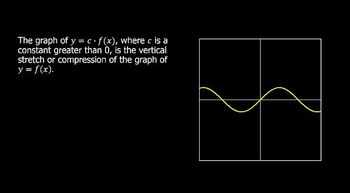Table of contents
- 0. Review of Algebra4h 16m
- 1. Equations & Inequalities3h 18m
- 2. Graphs of Equations43m
- 3. Functions2h 17m
- 4. Polynomial Functions1h 44m
- 5. Rational Functions1h 23m
- 6. Exponential & Logarithmic Functions2h 28m
- 7. Systems of Equations & Matrices4h 6m
- 8. Conic Sections2h 23m
- 9. Sequences, Series, & Induction1h 19m
- 10. Combinatorics & Probability1h 45m
3. Functions
Transformations
Problem 72
Textbook Question
In Exercises 67-80, begin by graphing the square root function, f(x) = √x. Then use transformations of this graph to graph the given function. h(x)=-√(x + 1)
 Verified step by step guidance
Verified step by step guidance1
Start by graphing the basic square root function \( f(x) = \sqrt{x} \). This graph is a curve that starts at the origin (0,0) and increases slowly to the right.
Next, consider the transformation \( \sqrt{x + 1} \). This represents a horizontal shift of the graph of \( \sqrt{x} \) to the left by 1 unit. So, the starting point of the graph moves from (0,0) to (-1,0).
Now, apply the negative sign in front of the square root: \( -\sqrt{x + 1} \). This reflects the graph of \( \sqrt{x + 1} \) over the x-axis, flipping it upside down.
The resulting graph of \( h(x) = -\sqrt{x + 1} \) starts at (-1,0) and decreases as it moves to the right, mirroring the shape of the original square root function but in the opposite direction.
Finally, ensure the domain of \( h(x) \) is considered. Since you cannot take the square root of a negative number, the domain of \( h(x) \) is \( x \geq -1 \).
Recommended similar problem, with video answer:
 Verified Solution
Verified SolutionThis video solution was recommended by our tutors as helpful for the problem above
Video duration:
2mPlay a video:
Was this helpful?
Key Concepts
Here are the essential concepts you must grasp in order to answer the question correctly.
Square Root Function
The square root function, f(x) = √x, is defined for x ≥ 0 and produces non-negative outputs. Its graph is a curve that starts at the origin (0,0) and increases gradually, reflecting the relationship between x and its square root. Understanding this function is crucial as it serves as the base for applying transformations.
Recommended video:

Imaginary Roots with the Square Root Property
Graph Transformations
Graph transformations involve shifting, reflecting, stretching, or compressing the graph of a function. In this case, the function h(x) = -√(x + 1) involves a horizontal shift to the left by 1 unit and a reflection across the x-axis. Mastery of these transformations allows for the accurate graphing of new functions based on known ones.
Recommended video:

Intro to Transformations
Reflection Across the X-Axis
Reflection across the x-axis occurs when the output values of a function are negated. For the function h(x) = -√(x + 1), this means that every point on the graph of f(x) = √(x + 1) is mirrored over the x-axis. This transformation changes the direction of the graph, flipping it upside down, which is essential for accurately representing the function.
Recommended video:

Reflections of Functions

 5:25m
5:25mWatch next
Master Intro to Transformations with a bite sized video explanation from Nick Kaneko
Start learningRelated Videos
Related Practice
























